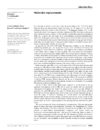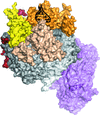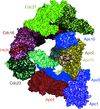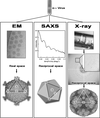issue contents
November 2013 issue
Molecular replacements
Proceedings of the CCP4 study weekend edited by Pietro Roversi, Helen Walden and Charles Ballard

Cover illustration: Solving nucleic acid structures by molecular replacement (p. 2174).
introduction
Open  access
access
 access
accessAn introduction to the proceedings of the CCP4 Study Weekend held at the East Midlands Conference Centre of the University of Nottingham, England, in January 2013.
research papers
Open  access
access
 access
accessTo be successful, molecular replacement relies on the quality of the model and of the crystallographic data. Some tricks that could be applied to the models or to the crystal to increase the success rate of MR are discussed here.
Open  access
access
 access
accessStrategies for phasing nucleic acid structures by molecular replacement, using both experimental and de novo designed models, are discussed.
Open  access
access
 access
accessThis study uses the Pfam database to show that the sequence redundancy of protein structures deposited in the PDB is increasing. The possible reasons behind this trend are discussed.
Open  access
access
 access
accessProcessing of NMR structures for molecular replacement by AMPLE works well.
Open  access
access
 access
accessModeling advances using Rosetta structure prediction to aid in solving difficult molecular-replacement problems are discussed.
Open  access
access
 access
accessA function for estimating the effective root-mean-square deviation in coordinates between two proteins has been developed that depends on both the sequence identity and the size of the protein and is optimized for use with molecular replacement in Phaser. A top peak translation-function Z-score of over 8 is found to be a reliable metric of when molecular replacement has succeeded.
Open  access
access
 access
accessProtein fragments suitable for use in molecular replacement can be generated by normal-mode perturbation, analysis of the difference distance matrix of the original versus normal-mode perturbed structures, and SCEDS, a score that measures the sphericity, continuity, equality and density of the resulting fragments.
Open  access
access
 access
accessThe crystallographic steps towards the structure determination of a complete eukaryotic exosome complex bound to RNA are presented. Phasing of this 11-protein subunit complex was carried out via molecular replacement.
PDB reference: 11-subunit exosome in complex with RNA, 4ifd
Open  access
access
 access
accessThis article describes an example of molecular replacement in which atomic models are used to interpret electron-density maps determined using single-particle electron-microscopy data.
Open  access
access
 access
accessA procedure for model building is described that combines morphing a model to match a density map, trimming the morphed model and aligning the model to a sequence.
Open  access
access
 access
accessUnder favourable circumstances, density modification and polyalanine tracing with SHELXE can be used to improve and validate potential solutions from molecular replacement.
Open  access
access
 access
accessAn unusual example of how virus structure determination pushes the limits of the molecular replacement method is presented.
Open  access
access
 access
accessA brief overview, with examples, of the evolution of molecular-replacement methods and models over the past few years is presented.
Open  access
access
 access
accessThe functionality of the molecular-replacement pipeline phaser.MRage is introduced and illustrated with examples.
Open  access
access
 access
accessThe use of molecular replacement in solving the structures of G protein-coupled receptors is discussed, with specific examples being described in detail.


 journal menu
journal menu
































